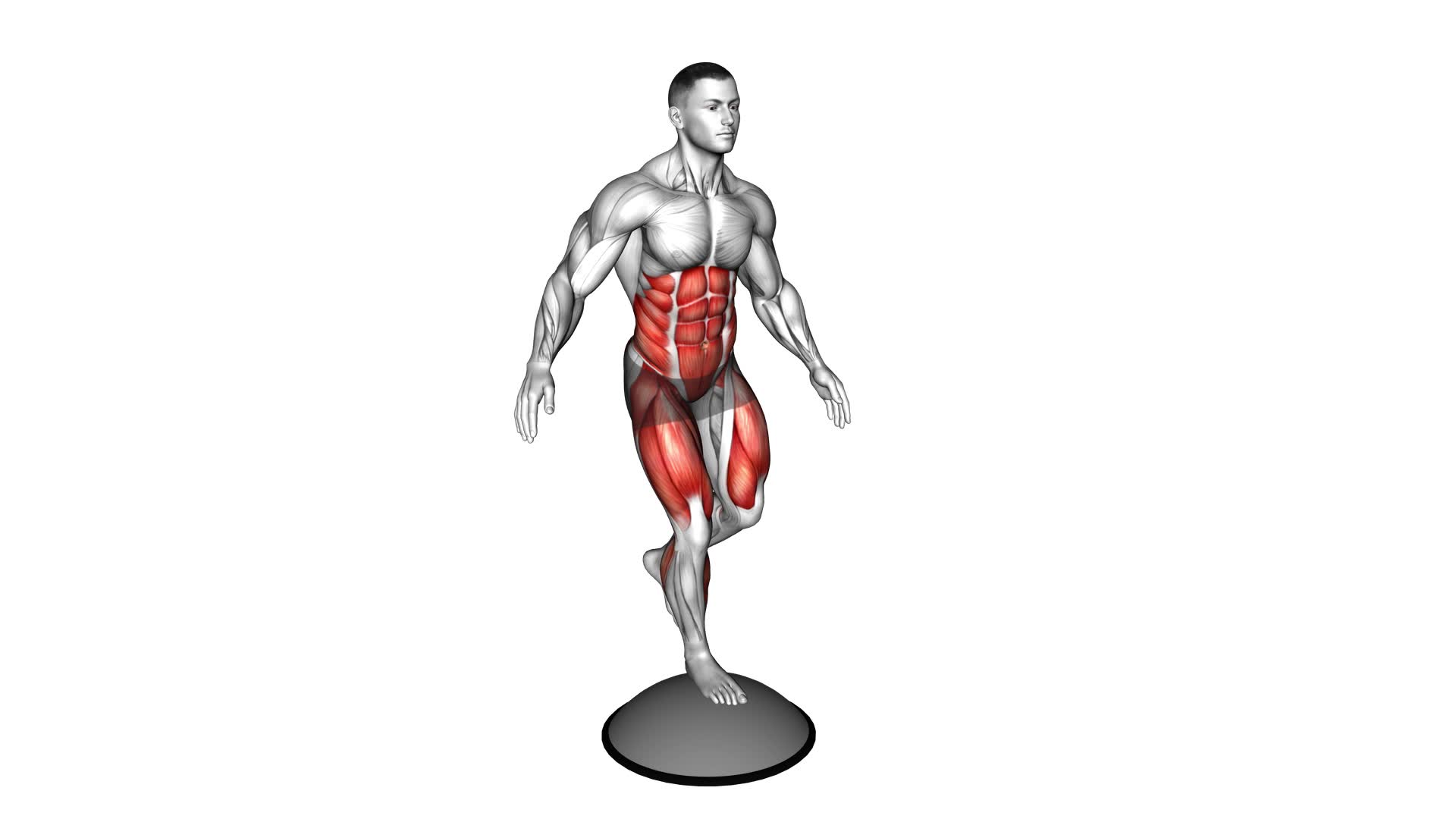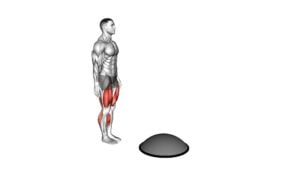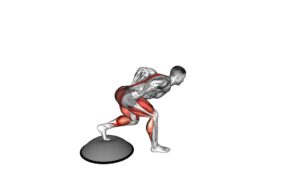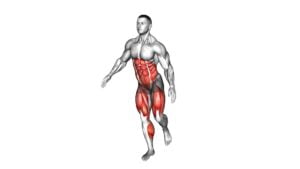Single Leg Stand on Bosu Ball – Video Exercise Guide & Tips

Are you looking to improve your balance and strengthen your legs? The Single Leg Stand on Bosu Ball is the perfect exercise for you!
Watch This Exercise Video
This video exercise guide and tips will show you the proper form and technique to get the most out of this exercise. Avoid common mistakes and learn modifications and progressions to challenge yourself.
Get ready to take your balance and leg strength to the next level with this effective exercise. Let's get started!
Key Takeaways
- Increased stability and improved balance
- Strengthening of lower body muscles
- Activation of core muscles
- Prevention of falls and injuries
Benefits of Single Leg Stand on Bosu Ball
You will experience increased stability and improved balance when performing the Single Leg Stand on Bosu Ball exercise. This exercise is highly effective in improving balance and strengthening the lower body.
By standing on one leg on the Bosu Ball, your body is forced to engage the muscles in your feet, ankles, and legs to maintain balance. This constant engagement helps to strengthen these muscles over time, leading to improved stability and balance in your everyday activities.
Additionally, the Single Leg Stand on Bosu Ball exercise also targets the core muscles. As you balance on one leg, your core muscles are activated to keep your body stable and aligned. This not only helps to improve your balance but also enhances your overall body strength and coordination.
Incorporating the Single Leg Stand on Bosu Ball exercise into your workout routine can have numerous benefits. It can help prevent falls and injuries by improving your balance and stability. It can also enhance your athletic performance by strengthening your lower body muscles, allowing you to generate more power and control in your movements.
Proper Form and Technique for Single Leg Stand on Bosu Ball
To execute the Single Leg Stand on Bosu Ball exercise with proper form and technique, maintain a stable position on the Bosu Ball while engaging your lower body and core muscles. Here are some tips to help you improve your balance and strengthen your lower body:
- Begin by standing in front of the Bosu Ball with your feet hip-width apart.
- Lift one foot off the ground and place it in the center of the Bosu Ball, with your toes pointing forward.
- Keep your standing leg slightly bent and your core engaged to maintain stability.
- Find your balance and focus on a point in front of you to help stabilize your body.
- Slowly raise your arms out to the sides for added balance.
By performing the Single Leg Stand on Bosu Ball exercise with proper form and technique, you can effectively improve your balance and strengthen your lower body. This exercise targets the muscles in your legs, particularly your calves, quadriceps, and glutes, while also engaging your core for stability.
Remember to start with shorter durations and gradually increase the time as you become more comfortable and confident in your balance.
Common Mistakes to Avoid During Single Leg Stand on Bosu Ball
Avoiding these common mistakes will help you perform the Single Leg Stand on Bosu Ball exercise correctly. Improving your balance is crucial for this exercise, but it's important to be mindful of the potential for common injuries.
One common mistake to avoid isn't properly engaging your core muscles. Your core plays a vital role in maintaining stability and balance, so make sure to activate those muscles throughout the exercise.
Another mistake isn't focusing on your alignment. Keep your standing leg straight and align your hips, knees, and ankles. This will help prevent strain on your joints and reduce the risk of injury.
Additionally, avoid looking down at your feet or the Bosu Ball. Instead, keep your gaze forward to maintain proper posture and balance.
Lastly, don't rush through the exercise. Take your time and focus on your form and balance.
Modifications and Progressions for Single Leg Stand on Bosu Ball
To modify or progress the Single Leg Stand on Bosu Ball exercise, incorporate variations that challenge your balance and strength. Here are some advanced variations to help you improve your balance and take your workout to the next level:
- Single Leg Stand with Arm Raises: Start by standing on one leg on the Bosu ball and raise your arms out to the sides or overhead while maintaining your balance. This variation adds an upper body challenge to the exercise.
- Single Leg Stand with Knee Lifts: Lift your knee up towards your chest while standing on one leg on the Bosu ball. This variation not only challenges your balance but also works your hip flexors and core muscles.
- Single Leg Stand with Medicine Ball Toss: Hold a medicine ball and toss it back and forth with a partner while standing on one leg on the Bosu ball. This variation adds an element of coordination and upper body strength to the exercise.
- Single Leg Stand with Eyes Closed: Close your eyes while standing on one leg on the Bosu ball. This variation removes visual cues, making it more challenging for your balance and proprioception.
- Single Leg Stand with Resistance Band: Attach a resistance band around your ankles and perform the single leg stand on the Bosu ball. The resistance band adds an additional challenge to your balance and strengthens your hip muscles.
Incorporating these advanced variations won't only enhance your balance improvements but also provide a more challenging and effective workout. Remember to progress gradually and listen to your body to avoid injury.
Expert Tips for Getting the Most Out of Single Leg Stand on Bosu Ball
Maximize your results with these 5 expert tips for getting the most out of the Single Leg Stand on Bosu Ball exercise.
- Focus on your balance: The Single Leg Stand on Bosu Ball exercise is great for improving balance, so make sure to concentrate on maintaining a stable position. Engage your core muscles and keep your body aligned.
- Start with the basics: If you're new to this exercise, begin by practicing the Single Leg Stand on a stable surface before progressing to the Bosu Ball. This will help you build a strong foundation and prevent injuries.
- Gradually increase the difficulty: As you become more comfortable with the exercise, challenge yourself by adding variations. Try closing your eyes or performing the exercise with your arms extended out to the sides. These variations will further enhance your balance and proprioception.
- Incorporate strength training: To maximize the benefits of the Single Leg Stand on Bosu Ball exercise, combine it with strength training exercises. This won't only improve your balance but also enhance your overall stability and muscular strength.
- Consult a professional: If you're a more advanced user or have specific goals in mind, consider working with a fitness professional who can provide personalized variations and guidance tailored to your needs. They can help you advance further and ensure you're performing the exercise correctly and safely.
Frequently Asked Questions
How Long Should I Hold the Single Leg Stand on the Bosu Ball?
To determine how long you should hold the single leg stand on the Bosu ball, it's important to consider your current fitness level and balance abilities. Start by holding the position for 10-15 seconds and gradually increase the time as you get more comfortable.
If you're looking for more challenge, you can try closing your eyes or adding arm movements.
Compared to other balance exercises, the single leg stand on the Bosu ball engages more muscles and improves stability.
Is It Normal to Feel Wobbly or Unstable While Performing the Single Leg Stand on the Bosu Ball?
Feeling wobbly or unstable during the single leg stand on the Bosu ball is normal, especially if you're just starting out. Many people make the common mistake of trying to rush the exercise without building a solid foundation of balance and stability.
To progress and master the single leg stand, start by focusing on maintaining good posture and engaging your core. Gradually increase the duration of each hold and challenge yourself by closing your eyes or performing dynamic movements.
Can the Single Leg Stand on the Bosu Ball Help Improve My Balance for Other Activities?
Improving your balance through yoga and using a stability ball for balance training can have several benefits.
One of these is that it can help you improve your balance for other activities.
By practicing the single leg stand on the Bosu ball, you can enhance your stability and control, which can translate into better balance in various movements and exercises.
Are There Any Specific Muscles That Are Targeted During the Single Leg Stand on the Bosu Ball?
During the single leg stand on the Bosu ball, specific muscles are targeted to improve your balance and stability. This exercise engages your core muscles, including your abdominals and lower back, as they work to maintain your balance on the unstable surface.
Additionally, your glutes, quadriceps, and calf muscles are activated to support your body weight and maintain proper alignment.
The benefits of the single leg stand on the Bosu ball include improved balance, coordination, and overall lower body strength.
Can I Incorporate Weights or Resistance Bands Into the Single Leg Stand on the Bosu Ball for Added Difficulty?
Yes, you can definitely incorporate weights or resistance bands into the single leg stand on the Bosu ball for added difficulty. By incorporating weights, you increase the load on your muscles, making the exercise more challenging and helping to build strength.
Resistance bands can also be used to add resistance and target specific muscle groups, providing additional benefits such as improved stability and balance.
Adding weights or resistance bands can enhance the effectiveness of the single leg stand on the Bosu ball.
Conclusion
In conclusion, the single leg stand on a Bosu ball is a challenging exercise that offers numerous benefits. By improving balance, stability, and core strength, it can enhance athletic performance and reduce the risk of injuries.
Remember to maintain proper form and technique, avoid common mistakes, and consider modifications or progressions to suit your fitness level. With these expert tips, you can maximize the effectiveness of this exercise and achieve your fitness goals.

Author
Years ago, the spark of my life’s passion ignited in my mind the moment I stepped into the local gym for the first time. The inaugural bead of perspiration, the initial endeavor, the very first surge of endorphins, and a sense of pride that washed over me post-workout marked the beginning of my deep-seated interest in strength sports, fitness, and sports nutrition. This very curiosity blossomed rapidly into a profound fascination, propelling me to earn a Master’s degree in Physical Education from the Academy of Physical Education in Krakow, followed by a Sports Manager diploma from the Jagiellonian University. My journey of growth led me to gain more specialized qualifications, such as being a certified personal trainer with a focus on sports dietetics, a lifeguard, and an instructor for wellness and corrective gymnastics. Theoretical knowledge paired seamlessly with practical experience, reinforcing my belief that the transformation of individuals under my guidance was also a reflection of my personal growth. This belief holds true even today. Each day, I strive to push the boundaries and explore new realms. These realms gently elevate me to greater heights. The unique combination of passion for my field and the continuous quest for growth fuels my drive to break new ground.







